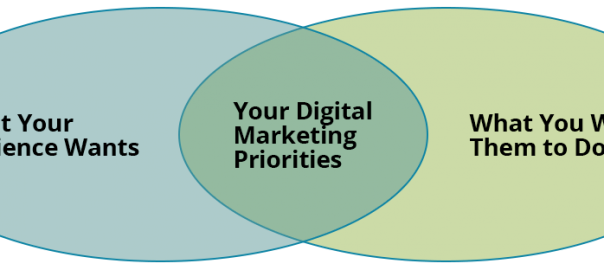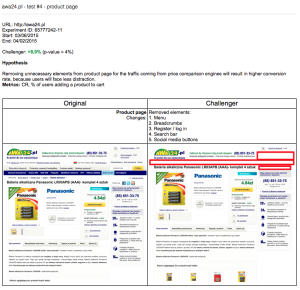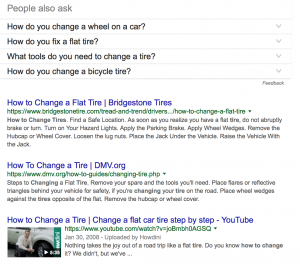SEO, search engine optimization, has been around for some time. SEO is the practice of optimizing your website’s code and content for maximum search engine visibility and rankings.
Our clients ask us about SEO all the time. They know that ranking well in search engines is important. This certainly hasn’t changed. And with Google’s upcoming algorithm change (the so-called Mobilegeddon), we can see that Google still holds power over your marketing decisions.
But are good rankings enough? Of course you want to drive traffic to your website. But what kind of traffic is it? What happens when that traffic gets to your website? Then what?
Digital Marketing Priorities
This is where many businesses fall short in their thinking and planning. A website today needs to be a resource for your target audience. And your audience is not always just potential clients. Your target audience is most likely a mix of the following:
- Potential Clients
- Current Clients
- Fans and Cheerleaders
Each of these groups is looking for something from you. And you’re trying to get each group to do something. It’s the intersection of these two things that makes for an effective website strategy.

Content for content’s sake is useless. So, a strategy based solely on adding content to improve your search engine rankings is no longer a relevant strategy. And I would argue that it’s never been a relevant strategy.
Utility Content
As Mark Schaefer put it in his new book, The Content Code, “it’s not about quantity or quality. It’s about UTILITY!” Or as Jay Baer calls it, Youtility.
You want to create content that serves a purpose or solves a problem. This is also called Utility Content.
Mark’s book outlines an issue facing so many businesses today which he calls Content Shock. If your industry is littered with “experts” churning out content day after day and it’s not much different than your content…that’s content shock.
You will likely never see a real return on that content because it is lost in the noise. This is also an issue with SEO. Google is organized noise. It’s your job to bring clarity.
Earned, Paid, And Owned Media
So, how do you drive qualified traffic to your site in a digital world full of noise? Well, you can either earn it or buy it:
- Earned Media – Search engine rankings, social media shares (also called shared media), reviews, etc.
- Paid Media – PPC and AdWords, social media advertising, traditional advertising, banner ads, retargeting, etc.
Today’s traffic is based on more than just content or keywords. It’s based on a combination of digital word of mouth (earned media) and advertising (paid media).
Your audience is looking for something specific from you. What is it? And when they find you, how will they know you’re the right company for their need? They want validation…
- You get good reviews.
- Your content is shared, liked, and syndicated.
- You rank well in the search engines.
- You have positive brand recognition.
- You are visible where it matters.
A top ranking in Google has never really been all the validation someone needs. Lots of terrible websites from shady looking companies continue to show up in search results. This is where your owned media comes in…
Owned media is the media that you control. Owned media could be any or all of the following:
Your…
- Website
- Mobile Website
- Blog
- Social Media Channels
It’s on these channels where you produce the utility content that works to build trust in your brand. By developing content that supports your digital marketing priorities – the intersection between what they want and what you want them to do – you are developing owned media that performs:
- Content is shared, your brand value improves, relevant backlinks are created.
- Potential clients find this content through social recommendations and/or search channels.
- Existing clients are reminded of your value to them and recommend you through their channels.
- Visitors sent through paid media take action based on your perceived value to them.
Content Ignition
But it isn’t enough just to create the content. As Mark Schaefer says “you need an ignition strategy.” How can you make sure your content is seen?
- You’ve shared your content on your social channels (in addition to valuable content from other sources).
- You post your content on channels like StumbleUpon, BizSugar, or industry specific content channels.
- You’ve syndicated your content to larger industry specific blogs.
- You’ve built a solid fanbase for your blog and social channels and these fans spread the love.
- You promote utility content or valuable offers through paid social campaigns.
- You share your content with your email newsletter list.
- You promote your website or blog with AdWords.
Remember, everybody wants something. Let’s take another look at those audience types:
- Potential clients – They want solutions to their problems. What problems can you solve for them? How can you offer solutions through your owned media that will win their trust, for free?
- Existing clients – They need ongoing support and education. How can your owned media channels support this?
- Fans and cheerleaders – They may not become clients but may have a large network. They find your content useful and share it with that network. In doing so they build their own personal brand by being a source of solutions, yours included.
As you can see, optimizing a website for search engine visibility is one small part of a much larger digital marketing strategy. And creating good content is no good unless that content is seen and shared. You need a plan for getting your content out there.
But it doesn’t stop there.
The Path To Conversion
What happens when someone gets to your owned media channels. What’s next? That’s a question that often goes unanswered. Think through the user’s experience and map that to your digital marketing priorities.
You are looking for conversions – converting a visitor into a client, subscriber, attendee – whatever action you want them to take. Look at your website to be certain that these next steps are very clear to the visitor…
- Your calls to action actually ask for action and are clear in their design and placement.
- The interface design of your website, mobile site, or blog lead the visitor down the path to conversion with visual and structural cues.
- You’ve eliminated any potential roadblocks that would get in the way of conversion.
- The steps following conversion make sense and reaffirm that they’ve made the right decision.
This will start to look like a circle…
The Circle Of Trust
You’ve earned attention and traffic through the recommendations of fans, followers, and even Google. You may have even paid for some traffic, but your website delivers on the promises of your ads. Visitors to your owned media share your content and/or convert into a client.
This is a circle of trust…
Circle of Trust Compilation Video from Alvarosolar
Are you in the circle of trust? I am watching you.
(219)







